Incidencia de fuegos en la Argentina durante las últimas dos décadas y su asociación con coberturas y usos del suelo en distintos contextos ambientales
El uso del fuego ha impulsado grandes cambios en la cobertura de la tierra. Aunque la ocurrencia de fuegos está modulada por condiciones climáticas y por la disponibilidad de biomasa combustible, el ser humano ha modificado los regímenes históricos de fuego mediante diversos mecanismos. En muchos ambientes, las actividades antrópicas son las moduladoras principales del régimen moderno de fuego. En este estudio analizamos la incidencia de fuego en la Argentina entre 2000 y 2019. En particular, 1) caracterizamos la ocurrencia de fuego a nivel provincial y 2) evaluamos el patrón espacial de la superficie quemada (SQ); en las zonas donde se concentró la SQ, 3) describimos el clima y la vegetación, y 4) evaluamos si distintas coberturas/usos del suelo se asociaron con atributos del régimen moderno de fuego (frecuencia y extensión). Entre 2000 y 2019 se quemaron 47.84 Mha, que se concentraron en el centro-norte de la Argentina. En dicha área se diferenciaron cuatro zonas climáticas (subtropical-húmeda, subtropical, templada y templada-semiárida), seis unidades de vegetación (Chaqueña, Monte, Pampeana, Espinal, Yungas y Paranaense) y siete conglomerados de asociación espacial entre coberturas/usos de suelo y fuego. Los fuegos asociados al uso intensivo del suelo ocurrieron mayormente en las zonas subtropical y templada, con vegetación de las unidades Chaqueña y Espinal. Los relacionados con usos de baja intensidad se registraron sobre todo en las zonas subtropical-húmeda y templadasemiárida, con vegetación de las unidades Monte y Paranaense. En la mayoría de los casos, el fuego se usó para disminuir o eliminar la cobertura de especies nativas, leñosas o herbáceas con el objetivo de promover el crecimiento de especies cultivadas (cereales, oleaginosas) o forrajeras (implantadas o autóctonas), para favorecer la producción agrícola o ganadera. Por lo tanto, los resultados sugieren que la elevada incidencia de fuego en el centro de la Argentina se asocia al sistema productivo actual.
[Palabras clave: deforestación, frontera agropecuaria, k-medias, MapBiomas, quemas, régimen de fuego, unidades de vegetación, uso agropecuario, uso ganadero, zonas climáticas]
INTRODUCCIÓN
MATERIALES Y MÉTODOS
1) Incidencia de fuego en el territorio argentino
2.a) Concentración espacial de la SQ (CESQ)
2.b) Caracterización espacio-temporal de la incidencia de fuego en el área de CESQ
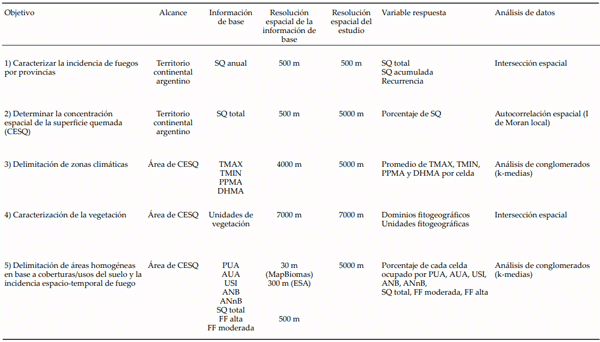
3) Caracterización climática y fitogeográfica en el área de CESQ
4) Caracterización de las coberturas y los usos del suelo en el área de CESQ
4) Asociación espacial entre coberturas/usos del suelo y regímenes modernos de fuego
RESULTADOS
1) Incidencia de fuego en el territorio argentino
2) Patrón espacial de la SQ
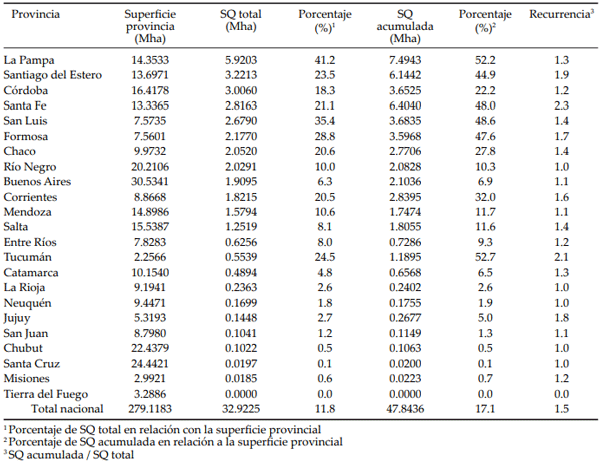
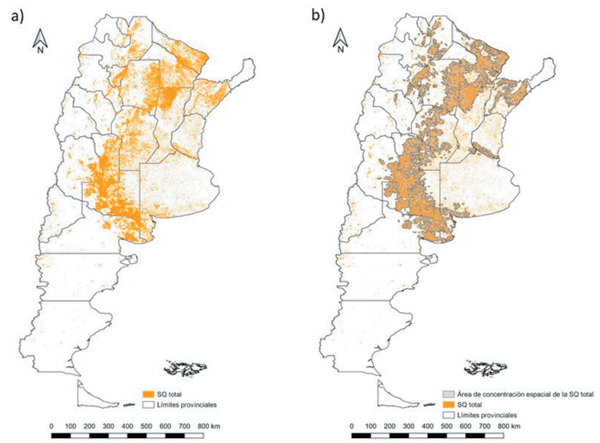
3) Caracterización climática y fitogeográfica del área de CESQ
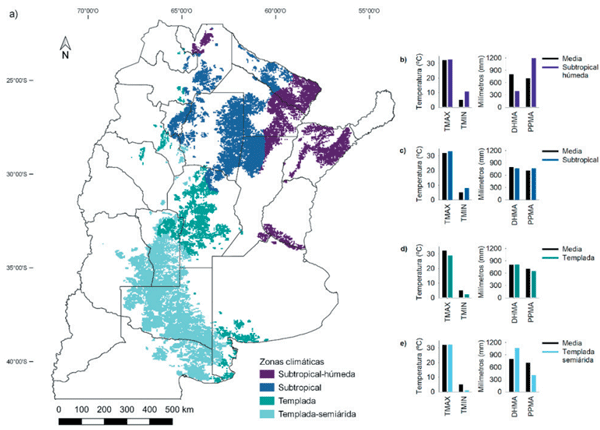
4) Asociación espacial entre coberturas/usos del suelo y el régimen moderno de fuego
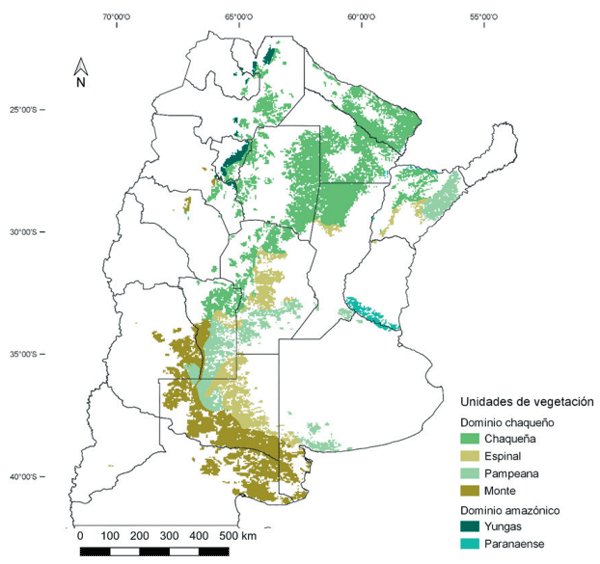
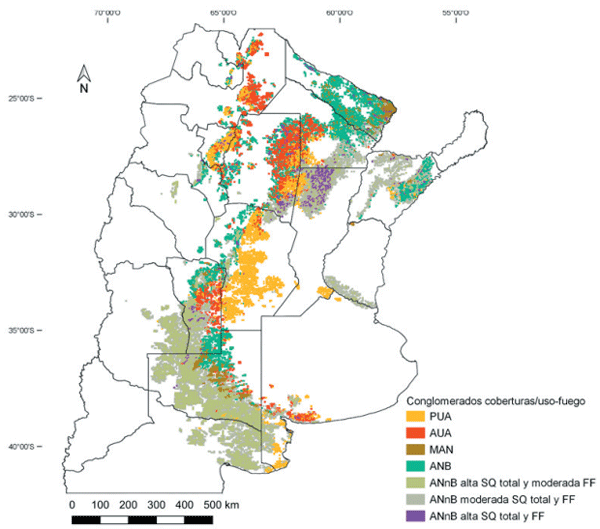
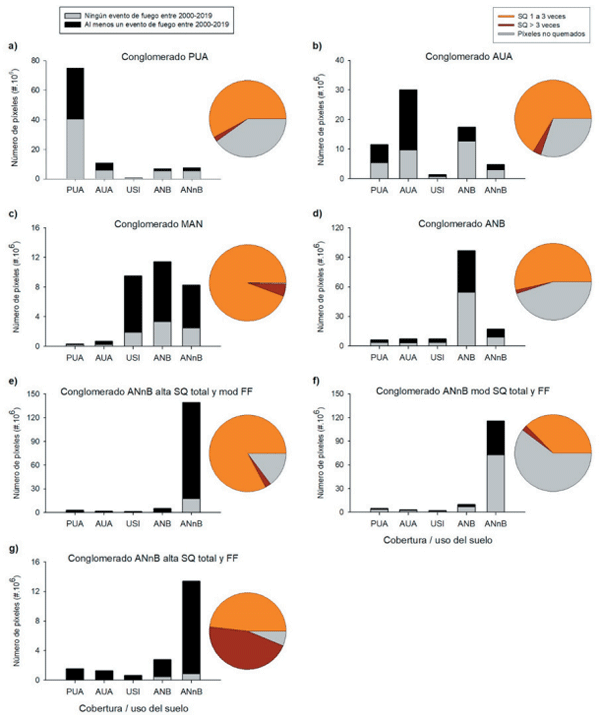
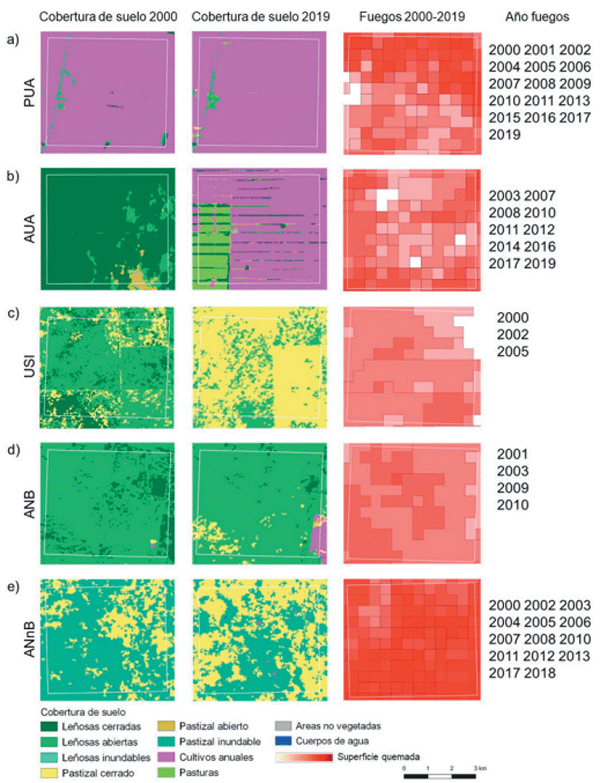
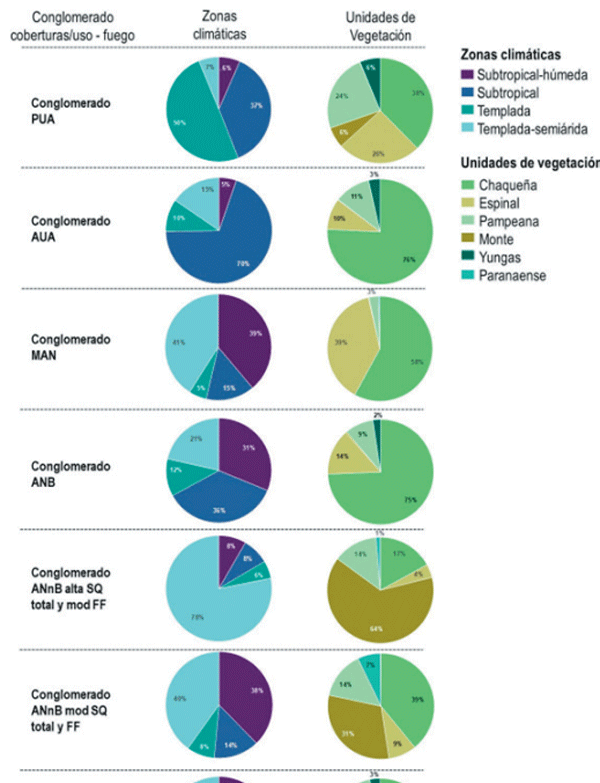
5) Contexto ambiental de los conglomerados coberturas/usos-fuego
DISCUSIÓN
Determinantes antrópicos de la ocurrencia de fuego
Limitaciones del estudio
Implicancias futuras
AGRADECIMIENTOS
Abatzoglou, J. T., S. Z. Dobrowski, S. A. Parks, and K. C. Hegewisch. 2018. Terraclimate, a high-resolution global dataset of monthly climate and climatic water balance from 1958-2015. Scientific Data 5(1):1-12. https://doi.org/ 10.1038/sdata.2017.191.
Anriquez, A., A. Albanesi, C. Kunst, R. Ledesma, C. López, A. Rodríguez Torresi, and J. Godoy. 2005. Rolado de fachinales y calidad de suelos en el Chaco occidental, Argentina. Ciencia del Suelo 23(2):145-157. URL: ref.scielo.org/tfbzd5.
Anselin, L. 1995. Local Indicators of Spatial Association - LISA. Geographical Analysis 27:93-115. https:/doi.org/10.1111/ j.1538-4632.1995.tb00338.x.
Anselin, L. 2005. Exploring spatial data with GeoDa. Urbana-Champaign, IL: Center for Spatially Integrated Social Science, University of Illinois. URL: geos.ed.ac.uk/~gisteac/fspat/geodaworkbook.pdf.
Archibald, S., W. J. Bond, W. D. Stock, and D. H. K. Fairbanks. 2005. Shaping the landscape: fire–grazer interactions in an African savanna. Ecol Appl 15(1):96-109. https://doi.org/10.1890/03-5210.
Archibald, S. 2016. Managing the human component of fire regimes: Lessons from Africa. Philosophical Transactions of the Royal Society B: Biological Sciences 371. https:/doi.org/10.1098/rstb.2015.0346.
Argañaraz, J. P., G. G. Pizarro, M. Zak, M. A. Landi, and L. M. Bellis. 2015. Human and biophysical drivers of fires in Semiarid Chaco mountains of Central Argentina. Sci Total Environ 520:1-12. https:/doi.org/10.1016/ j.scitotenv.2015.02.081.
Argañaraz, J. P., A. M. Cingolani, L. M. Bellis, and M. A. Giorgis. 2020. Fire incidence along an elevation gradient in the mountains of central Argentina. Ecología Austral 30:268-281. https://doi.org/10.25260/EA.20.30.2.0.1054.
Armenteras, D., C. Gibbes, C. A. Vivacqua, J. S. Espinosa, W. Duleba, F. Goncalves, and C. Castro. 2016. Interactions between climate, land use and vegetation fire occurrences in El Salvador. Atmosphere 7(2):26. https://doi.org/10.3390/ atmos7020026.
Assembly, G. 2015. Sustainable development goals. SDGs Transform Our World 2030:6-28.
Barral, M. P., S. Villarino, C. Levers, M. Baumann, T. Kuemmerle, and M. Mastrangelo. 2020. Widespread and major losses in multiple ecosystem services as a result of agricultural expansion in the Argentine Chaco. J Appl Ecol 57: 2485-2498. https:/doi.org/10.1111/1365-2664.13740.
Baumann, M., I. Gasparri, M. Piquer-Rodríguez, G. Gavier Pizarro, P. Griffiths, P. Hostert, and T. Kuemmerle. 2017. Carbon emissions from agricultural expansion and intensification in the Chaco. Global Change Biology 23:1902-1916. https:/doi.org/10.1111/gcb.13521.
Blackhall, M., T. T. Veblen, and E. Raffaele. 2015. Recent fire and cattle herbivory enhance plant-level fuel flammability in shrublands. J Veg Sci 26(1):123-133. https:/doi.org/10.1111/jvs.12216.
Blackhall, M., E. Raffaele, J. Paritsis, F. Tiribelli, J. M. Morales, T. Kitzberger, et al. 2017. Effects of biological legacies and herbivory on fuels and flammability traits: A long-term experimental study of alternative stable states. J Ecol 105(5):1309-1322. https:/doi.org/10.1111/1365-2745.12796.
Bond, W. J., F. I. Woodward, and G. F. Midgley. 2005. The global distribution of ecosystems in a world without fire. New Phytol 165:525-537. https:/doi.org/10.1111/j.1469-8137.2004.01252.x.
Bowman, D. M., J. K. Balch, P. Artaxo, W. J. Bond, J. M. Carlson, M. A. Cochrane, et al. 2009. Fire in the Earth system. Science 324(5926):481-484. https:/doi.org/10.1126/science.1163886.
Bowman, D. M., J. Balch, P. Artaxo, W. J. Bond, M. A. Cochrane, C. M. D’Antonio, et al. 2011. The human dimension of fire regimes on Earth. J Biogeography 38(12):2223-2236. https:/doi.org/10.1111/j.1365-2699.2011.02595.x.
Briske, D. D. 2017. Rangeland systems: processes, management and challenges. Springer Nature. Pp. 661. https: /doi.org/10.1007/978-3-319-46709-2.
Bruera, B. M., and F. A. I. González. 2021. Deforestación, incendios forestales y expansión de la frontera agrícola en el Norte Grande argentino (2007-2018). Rev Facultad de Cs Económicas 26(1):127-144. https:/doi.org/10.30972/ rfce.2615038.
Cabrera, A. L. 1976. Regiones fitogeográficas argentinas. Pp. 1-85 en W. F. Kugler (ed.). Enciclopedia Argentina de Agricultura y Jardinería. Tomo 2. 2da edición. Acme, Buenos Aires, Argentina. Fascículo 1.
Cardil, A., S. De-Miguel, C. A. Silva, P. B. Reich, D. Calkin, P. H. S. Brancalion, A. C. Vibrans, et al. 2019. Recent deforestation drove the spike in Amazonian fires. Environ Res Let 15:121003. https:/doi.org/10.1088/1748-9326/ abcac7.
Castagnani, L., E. Jozami, J. C. Porstmann, M. Sacido, and S. Feldman. 2018. Bioenergía y ganadería sobre pastizales naturales santafesinos: alternativas complementarias. Agromensajes 33-34. URL: tinyurl.com/bdhwwzr3.
Cavallero, L., D. R. López, E. Raffaele, and M. A. Aizen. 2015. Structural–functional approach to identify post-disturbance recovery indicators in forests from northwestern Patagonia: a tool to prevent state transitions. Ecol Ind 52:85-95. https: /doi.org/10.1016/j.ecolind.2014.11.019.
Chuvieco, E., and E. S. Kasischke. 2007. Remote sensing information for fire management and fire effects assessment. J Geophysical Res: Biogeosciences 112(G1). https:/doi.org/10.1029/2006JG000230.
Coirini, R., and U. Karlin. 2000. Potencialidad económica de bosques con algarrobos. I: propuesta de uso múltiple para el Chaco árido. Multequina 9(2):133-145.
Collins, M. 2000. Understanding uncertainties in the response of ENSO to greenhouse warming. Geophysical Res Lett 27(21):3509-3512. https:/doi.org/10.1029/2000GL011747.
Cravero, S. A. C., C. Bianchi, H. J. Elena, and A. R. Bianchi. 2017. Clima de Argentina: Mapas digitales mensuales de precipitación y precipitación menos evapotranspiración potencial. Adenda del Atlas climático digital de la República Argentina.
Curtis, P. G., C. M. Slay, N. L. Harris, A. Tyukavina, and M. C. Hansen. 2018. Classifying drivers of global forest loss. Science 361:1108-1111. https:/doi.org/10.1126/science.aau3445.
de Abelleyra D., S. Banchero, S. Verón, J. Mosciaro, and J. Volante. 2019. Mapa Nacional de Cultivos campaña 2018/2019. Colección 1. Versión 1. Informe. Instituto Nacional de Tecnología Agropecuaria (INTA), Argentina.
De Marzo, T., N. I. Gasparri, E. F. Lambin, and T. Kuemmerle. 2022. Agents of Forest Disturbance in the Argentine Dry Chaco. Remote Sensing 14:1758. https://doi.org/10.3390/rs14071758.
ESA. 2017. Land Cover CCI Product User Guide Version 2. Tech Rep.
ESRI. 2011. ArcGIS Desktop: Release 10. Redlands, CA: Environmental Systems Research Institute.
FAO .2010. Evaluación de los recursos forestales mundiales 2010. Informe nacional: Argentina. URL: fao.org/3/al445S/ al445S.pdf.
FAO. 2018. Los 10 Elementos de la Agroecología: Guía para la transición hacia sistemas alimentarios y agrícolas sostenibles. Editorial FAO. Pp. 15. URL: fao.org/3/i9037es/i9037es.pdf.
Feldman, S. R., and J. P. Lewis. 2005. Effects of fire on the structure and diversity of a Spartina argentinensis tall grassland. Appl Veg Sci 8(1):77-84. https:/doi.org/10.1111/j.1654-109X.2005.tb00631.x.
Fernández Palma, G. 2009. Agricultura certificada: una nueva revolución en el sector agropecuario. Rev Bolsa de Comercio de Rosario 1508:30-36. URL: bcr.com.ar/sites/default/files/aapresid.pdf.
Fick, S. E., and R. J. Hijmans. 2017. WorldClim 2: new 1km spatial resolution climate surfaces for global land areas. Int J Climatology 37(12):4302-4315. https:/doi.org/10.1002/joc.5086.
Garibaldi, L. A., and N. Pérez-Méndez. 2019. Positive outcomes between crop diversity and agricultural employment worldwide. Ecological Economics 164(C):106358. https:/doi.org/10.1016/j.ecolecon.2019.106358.
Gasparri, N. I., and H. R. Grau. 2005. Patrones regionales de deforestación en el subtrópico argentino y su contexto ecológico y socioeconómico. Pp. 442-446 en A. Brown, U. Martínez Ortiz, M. Acerbi and J. Corcuera (eds.). Situación Ambiental Argentina 2005. URL: tinyurl.com/4tvv4z6u.
Gasparri, N. I., and H. R. Grau. 2009. Deforestation and fragmentation of Chaco dry forest in NW Argentina (1972- 2007). Forest Ecol Manage 258(6):913-921. https:/doi.org/10.1016/j.foreco.2009.02.024.
Giglio, L., L. Boschetti, D. P. Roy, A. A. Hoffman, M. Humber, and J. V. Hall. 2018. Collection 6 MODIS Burned Area Product User’s Guide. Version 1.2. URL: tinyurl.com/2anhy9ab.
Giorgis, M. A., S. R. Zeballos, L. Carbone, H. Zimmermann, H. von Wehrden, R. Aguilar, et al. 2021. A review of fire effects across South American ecosystems: the role of climate and time since fire. Fire Ecol 17(1):1-20. https:/doi.org/ 10.1186/s42408-021-00100-9.
Habert, H., K. H. Erb, F. Krausmann, V. Gaube, A. Bondeau, C. Plutzar, S. Gingrich, W. Lucht, and M. Fischer-Kowaski. 2007. Quantifying and mapping the human appropiation of net primary production in earth’s terrestrial ecosystems. PNAS 104:12942-12947. https://doi.org/10.1073/pnas.0704243104.
Hantson, S., M. Padilla, D. Corti, and E. Chuvieco. 2013. Strengths and weaknesses of MODIS hotspots to characterize global fire occurrence. Remote Sens Environ 131:152-159. https:/doi.org/10.1016/j.rse.2012.12.004.
Harris, I., P. D. Jones, T. J. Osborn, and D. H. Lister. 2014. Updated high-resolution grids of monthly climatic observations - the CRU TS3.10 Dataset. Int J Climatology 34:623-642. https://doi.org/10.1002/joc.3711.
Hartigan, J. A., and M. A. Wong. 1979. Algorithm AS 136: A k-medias Clustering Algorithm. J Royal Stat Soc, Series C (Applied Statistics) 28(1):100-108. https://doi.org/10.2307/2346830.
Hoyos, L. E., A. M. Cingolani, M. R. Zak, M. V. Vaieretti, D. E. Gorla, and M. R. Cabido. 2013. Deforestation and precipitation patterns in the arid Chaco forests of central Argentina. Appl Veg Sci 16(2):260-271. https:/doi.org/ 10.1111/j.1654-109X.2012.01218.x.
IPCC. 2022. Climate Change 2022: Impacts, Adaptation and Vulnerability. Contribution of Working Group II to the Sixth Assessment Report of the Intergovernmental Panel on Climate Change. Pp. 3056 en H. O. Pörtner, D. C. Roberts, M. Tignor, E. S. Poloczanska, K. Mintenbeck, A. Alegría, M. Craig, S. Langsdorf, S. Löschke, V. Möller, A. Okem and B. Rama (eds.). Cambridge University Press. Cambridge University Press, Cambridge, UK and New York, NY, USA.
Ipiña, A., G. M. Salum, E. Crinó, and R. D. Piacentini. 2012. Satellite and ground detection of very dense smoke clouds produced on the islands of the Paraná river delta that affected a large region in Central Argentina. Advances in Space Research 49(5):966-977. https://doi.org/10.1016/j.asr.2011.12.009.
Jozami, E., A. Shocron, J. C. Porstmann, and S. Feldman. 2015. Pastizales naturales C4: una propuesta de manejo bioenergético-pastoril. Agromensajes Especial 57-60. URL: fcagr.unr.edu.ar/?p=6282.
Jozami, E., L. L. Sosa, and S. R. Feldman. 2013. Spartina argentinensis as feedstock for bioethanol and pellets production. Applied Technologies and Innovations 9:37-44. https:/doi.org/10.15208/ati.2013.8.
Kauffman, J. B., D. L. Cummings, and D. E. Ward. 1998. Fire in the Brazilian Amazon 2. Biomass, nutrient pools and losses in cattle pastures. Oecologia 113:415-427. https://doi.org/10.1007/s004420050394.
Kaufman, L., and P. Rousseeuw. 2005. Finding Groups in Data: An Introduction to Cluster Analysis. New York, NY. John Wiley.
Kitzberger, T., and T. T. Veblen. 1999. Fire-induced changes in northern Patagonian landscapes. Landscape Ecology 14:1-15. https://doi.org/10.1023/A:1008069712826.
Kitzberger, T., E. Aráoz, J. H. Gowda, M. Mermoz, and J. M. Morales. 2012. Decreases in fire spread probability with forest age promotes alternative community states, reduced resilience to climate variability and large fire regime shifts. Ecosystems 15(1):97-112. https:/doi.org/10.1007/s10021-011-9494-y.
Kitzberger, T. 2015. Relación entre el clima y los grandes incendios forestales en el noroeste de la Patagonia. Revista Desde La Patagonia Difundiendo Saberes 12(19):32-34. URL: tinyurl.com/ycxakyyx.
Kowaljow, E., M. S. Morales, J. L. Whitworth-Hulse, S. R. Zeballos, M. A. Giorgis, M. R. Catón, and D. E. Gurvich. 2019. A 55-year-old natural experiment gives evidence of the effects of changes in fire frequency on ecosystem properties in a seasonal subtropical dry forest. Land Deg Dev 30(3):266-277. https://doi.org/10.1002/ldr.3219.
Kunst, C. 2011. Ecología y uso del fuego en la región chaqueña Argentina. Boletín informativo CIDEU 10:81-105. URL: tinyurl.com/yc7pxx72.
Kunst, C., R. Ledesma, M. B. Nickish, G. Angella, D. Prieto, and J. Godoy. 2003. Rolado de “fachinales” e infiltración de agua en suelo en El Chaco Occidental (Argentina). Revista de Investigaciones Agropecuarias 32(3):105-126. URL: redalyc.org/pdf/864/86432306.pdf.
Kunst, C., R. Ledesma, and M. Navall. 2008. Rolado Selectivo de Baja intensidad. Ed. INTA EEA Santiago del Estero, Argentina.
Lima, A., T. S. F. Silva, R. M. de Feitas, M. Adami, A. R. Formaggio, and Y. E. Shimabukuro. 2012. Land use and land cover changes determine the spatial relationship between fire and deforestation in the Brazilian Amazon. Applied Geography 34:239-246. https://doi.org/10.1016/j.apgeog.2011.10.013.
Lizárraga, L., L. Rivera, P. Názaro, and N. Politi. 2023. El Bosque Pedemontano en llamas: situación de incendios forestales en las provincias de Salta y Jujuy entre 2012-2022. Informe Técnico Administración de Parques Nacionales, Dirección Regional Noroeste. URL: tinyurl.com/5ajpck3z.
Machado, R. 2012. Cambios en la estructura, la población y la composición de accesiones de Panicum maximum sometidas a pastoreo. Pastos y Forrajes 35(2):165-174. URL: http://scielo.sld.cu/pdf/pyf/v35n2/pyf04212.pdf.
Manuel-Navarrete, D., G. C. Gallopín, M. Blanco, M. Díaz-Zorita, D. Ferraro, H. Herzer, et al. 2005. Análisis sistémico de la agriculturización en la pampa húmeda argentina y sus consecuencias en regiones extra pampeanas: sostenibilidad, brechas de conocimiento e integración de políticas. CEPAL.
Mc Granahan, D. A., and C. L. Wonkka. 2020. Ecology of Fire-Dependent Ecosystems: Wildland Fire Science, Policy, and Management. CRC Press. Pp. 266. https://doi.org/10.2989/10220119.2021.1926324.
Menghi, M., and M. Herrera. 1998. Modelo de estados y transiciones para pastizales del valle de inundación del Rio Dulce (depresión de Mar Chiquita, Córdoba, Argentina). Ecotrópicos 11:131-140. URL: tinyurl.com/5cfuvxm6.
Mónaco, M., P. L. Peri, F. A. Medina, H. Colomb, V. A. Rosales, F. Berón, E. Manghi, et al. 2020. Causas e impactos de la deforestación de los bosques nativos de Argentina y propuestas de desarrollo alternativas. Dirección Nacional de Bosques, Ministerio de Ambiente y Desarrollo Sostenible (MAyDS): Buenos Aires, Argentina. Pp. 60. URL: tinyurl.com/3846c54s.
Morán, P. A. P. 1948. The Interpretation of Statistical Maps. Biometrika 35:255-60. https:/doi.org/10.1111/j.2517- 6161.1948.tb00012.x.
Murphy, B. P., and D. M. Bowman. 2007. The interdependence of fire, grass, kangaroos and Australian Aborigines: a case study from central Arnhem Land, northern Australia. J Biogeography 34(2):237-250. https:/doi.org/10.1111/j.1365-2699.2006.01591.x.
Millán, A., B. Ferrero, and B. A. Bilbao. 2022 Traditional knowledge of fire use by islanders in the Paraná Delta, Argentina. Tropical Forest Issues 61:60-65. https://doi.org/10.55515/AEKO2020.
Mosciaro, M. J., L. Seghezzo, M. Texeira, J. Paruelo, and J. Volante. 2023. Where did the forest go? Post-deforestation land use dynamics in the Dry Chaco region in Northwestern Argentina. Land Use Policy 129:106650. https://doi.org/ 10.1016/j.landusepol.2023.106650.
Moscovich, F. A., F. Ivandic, and L. C. Besold. 2014. Manual de combate de incendios forestales y manejo de fuego. Nivel Inicial. Ediciones INTA.
Nasi, R., R. Dennis, E. Meijaard, G. Applegate, and P. Moore. 2002. Los incendios forestales y la diversidad biológica. Unasylva. Ediciones FAO. URL: fao.org/3/y3582s/y3582s08.htm.
Oyarzabal, M., J. Clavijo, L. Oakley, F. Biganzoli, P. Tognetti, I. Barberis, et al. 2018. Unidades de vegetación de la Argentina. Ecología Austral 28(1):40-63. https://doi.org/10.25260/EA.18.28.1.0.399.
Paritsis, J., T. T. Veblen, and A. Holz. 2015. Positive fire feedbacks contribute to shifts from Nothofagus pumilio forests to fire-prone shrublands in Patagonia. J Veg Sci 26:89-101. https://doi.org/10.1111/jvs.12225.
Paruelo, J. M., J. P. Guerschman, G. Piñeiro, E. G. Jobbágy, S. R. Verón, G. Baldi, and S. Baeza. 2006. Cambios en el uso de la tierra en Argentina y Uruguay. Agrociencia Uruguay 10(2):47-61. URL: http://hdl.handle.net/10625/47410.
Paruelo, J. M., J. P. Guerschman, and S. R. Verón. 2005. Expansión agrícola y cambios en el uso del suelo. Ciencia Hoy 15:14-23. URL: tinyurl.com/jrtzchee.
Paruelo, J. M., M. Oesterheld, F. Del Pino, J. P. Guerschmann, G. Piñeiro Guerra, J. Volante, G. Baldi, C. Caride, A. D. M. Vasallo, L. Porfirio, and M. Durante. 2004.
Patrones Espaciales y Temporales de la Expansión de Soja en Argentina: Relación con Factores Socio-Económicos y Ambientales. Informe final LART/FAUBA al Banco Mundial. Pp. 87. URL: tinyurl.com/yakm8wbh.
Pellegrini, A. F., A. Ahlström, S. E. Hobbie, P. B. Reich, L. P. Nieradzik, A. C. Staver, et al. 2018. Fire frequency drives decadal changes in soil carbon and nitrogen and ecosystem productivity. Nature 553(7687):194-198. https:/doi.org/ 10.1038/nature24668.
Peri, P. L., D. R. López, V. Rusch, G. Rusch, Y. M. Rosas, and G. Martínez Pastur. 2017. State and transition model approach in native forests of Southern Patagonia (Argentina): linking ecosystem services, thresholds and resilience. Int J Biod Sci Ecosystem Services Manag 13(2):105-118. https:/doi.org/10.1080/21513732.2017.1304995.
Peri, P. L., G. J. Martínez Pastur, and T. M. Schlichter. 2021. Uso sostenible del bosque. Aportes desde la Silvicultura Argentina. Ministro de Ambiente y Desarrollo Sostenible de la Nación.
Peri, P. L., Y. M. Rosas, D. R. López, M. V. Lencinas, L. Cavallero, and G. J. Martínez Pastur. 2022a. Conceptual framework to define management strategies for silvopastoral systems in native forests. Ecología Austral 32:749-766. https://doi.org/10.25260/EA.22.32.2.1.1872.
Peri, P. L., M. Mónaco, M. Navall, H. Colomb, G. Gómez Campero, A. Medina, and V. Rosales. 2022b. Manejo de bosques con ganadería integrada (MBGI) en Argentina. En Oportunidades y desafíos del uso de los bosques nativos integrados a la producción ganadera de Uruguay. Serie Técnica INIA Nº 261. https://doi.org/10.35676/INIA/ST.261.
Piriz-Carrillo, V. R., N. Gasparri, L. Paolini, and R. Grau. 2010. Monitoreo satelital de fuegos en el área cañera de la provincia de Tucumán. Selper 2:5-12. URL: ri.conicet.gov.ar/handle/11336/73581.
Preiti, F. J. 2020. Fuego en las islas, humo en los medios: Reflexiones sobre los discursos acerca de las quemas en las islas del Delta paranaense. Revista Chilena de Semiótica 14:133-148.
Popescu, A., A. Paulson, A. C. Christianson, A. S. Sullivan, A. Tulloch, B. Bilbao, et al. 2022. Spreading like wildfire: The rising threat of extraordinary landscape fires-A rapid response assessment. Editorial PNUMA- GRID Arendal. URL: wedocs.unep.org/20.500.11822/38372.
Proyecto MapBiomas Chaco - Colección 2.0 de la Serie Anual de Mapas de Cobertura y Uso del Suelo del Chaco, adquirido el 29/04/21. URL: tinyurl.com/2v6j58fe.
Proyecto MapBiomas Pampa Sudamericano - Colección 1.0 de la Serie Anual de Mapas de Cobertura y Uso del Suelo del Pampa Sudamericano. URL: tinyurl.com/yt3yputz.
QGIS.org. 2022. QGIS Geographic Information System. QGIS Association. URL: qgis.org.
Renison, D., A. M. Cingolani, and R. Suárez. 2002. Efectos del fuego sobre un bosquecillo de Polylepis australis (Rosaceae) en las montañas de Córdoba, Argentina. Rev Chil Hist Nat 75:719-727. https://doi.org/ 10.4067/S0716-078X2002000400007.
Robertson, G. P., S. K. Hamilton, B. L. Barham, B. E. Dale, R. C. Izaurralde, R. D. Jackson, D. A. Landis, S. M. Swinton, K. D. Thelen, and J. M. Tiedje. 2017. Cellulosic biofuel contributions to a sustainable energy future: Choices and outcomes. Science 356. https:/doi.org/10.1126/science.aal2324.
Rusch, V. E., D. R. López, L. Cavallero, G. Rusch, L. Garibaldi, J. Grosfeld, and P. L. Peri. 2017. Modelo de estados y transiciones de los ñirantales del NO de la Patagonia como herramienta para el uso silvopastoril sustentable. Ecología Austral 27(2):266-278. https://doi.org/10.25260/EA.17.27.2.0.240.
Salvia, M., D. Ceballos, F. Grings, H. Karszenbaum, and P. Kandus. 2012. Post-fire effects in wetland environments: landscape assessment of plant coverage and soil recovery in the Parana River Delta Marshes, Argentina. Fire Ecology 8:17-37. https://doi.org/10.4996/fireecology.0802017.
SENASA. 2021. Censo Nacional Agropecuario 2018: Resultados definitivos. Instituto Nacional de Estadística y Censos (INDEC). URL: tinyurl.com/5dhuep9u.
SENASA. 2020. Censo Nacional Agropecuario 2018: Ganadería Instituto Nacional de Estadística y Censos (INDEC). URL: tinyurl.com/35w9586w.
Shvidenko, A., C. V. Barber, and R. Persson 2005. Forest and Woodland Systems. Chapter 21. Pp. 585-621 en R. Hassan, R. Scholes and N. Ash (eds.). Ecosystems and human well-being: current state and trends. FAO, Rome.
Sica, Y. V., R. D. Quintana, V. C. Radeloff, and G. I. Gavier-Pizarro. 2016. Wetland loss due to land use change in the Lower Paraná River Delta, Argentina. Science of the Total Environment 568:967-978. https://doi.org/10.1016/ j.scitotenv.2016.04.200.
Smith, R, M. Adams, S. Maier, R. Craig, A. Kristina and I. Maling. 2007. Estimating the area of stubble burning from the number of active fires detected by satellite. Remote Sensing of Environment 109:95-106. https:/doi.org/10.1016/ j.rse.2006.12.011.
Song, X. P., M. Hansen, P. Potapov, B. Adusei, J. Pickering, M. Adami, A. Lima, V. Zalles, S. Stehman, et al. 2021. Massive soybean expansion in South America since 2000 and implications for conservation. Nature Sustainability 4(9):784-792. https:/doi.org/10.1038/s41893-021-00729-z.
Suyanto, S., G. Applegate, R. P. Permana, N. Khususiyah, and I. Kurniawan. 2004. The role of fire in changing land use and livelihoods in Riau-Sumatra. Ecology and Society 9(1):15. https://doi.org/10.5751/es-00632-090115.
Tedim, F., and V. Leone. 2020. The dilemma of wildfire definition: What it reveals and what it implies. Frontiers in Forests and Global Change 134. https://doi.org/10.3389/ffgc.2020.553116.
Tiribelli, F., T. Kitzberger, and J. M. Morales. 2018. Changes in vegetation structure and fuel characteristics along post-fire succession promote alternative stable states and positive fire-vegetation feedbacks. J Veg Sci 29(2):147-156. https:/doi.org/10.1111/jvs.12620.
Torres, R. C., M. A. Giorgis, C. Trillo, L. Volkmann, P. Demaio, J. Heredia, and D. Renison. 2014. Post-fire recovery occurs overwhelmingly by resprouting in the Chaco Serrano forest of Central Argentina: Post-fire tree regeneration. Austral Ecol 39:346-354. https://doi.org/10.1111/aec.12084.
Trigo, E., E. Cap, V. Malach, and F. Villareal. 2009. The Case of Zero-Tillage Technology in Argentina. IFPRI Discussion Paper 915:32.
Valeiro, A., and C. Biaggi. 2019. Revisión crítica de la evolución tecnológica de la cosecha de la caña de azúcar en la Argentina. Revista de Investigaciones Agropecuarias 45:31-43. URL: tinyurl.com/2p8pn726.
Valiente, S., C. Kunst, and S. R. Feldman. 2021. Efectos de secuencias de disturbios sobre la acumulación de biomasa y su calidad forrajera en un pajonal de Spartina spartinae (Trin) Merr Ex Hitchc. Revista de Investigaciones Agropecuarias 47(2):170-175. URL: redalyc.org/journal/864/86469002001/html.
Vaz, A. 2020. Trinational Report: Fires and deforestation in territories with a documented presence of indigenous peoples in isolation - PIA - Bolivia - Brazil - Paraguay. Brasilia-DF (Brazil): GTI PIACI.
Watson, P. J., R. A. Bradstock, and E. C. Morris. 2009. Fire frequency influences composition and structure of the shrub layer in an Australian subcoastal temperate grassy woodland. Austral Ecol 34(2):218-232. https:/doi.org/10.1111/j.1442- 9993.2008.01924.x.
Whitlock, C., P. E. Higuera, D. B. McWethy, and C. E. Briles. 2010. Paleoecological Perspectives on Fire Regime Concept. The Open Ecol J 3:6-23. https://doi.org/10.2174/1874213001003020006.
Zak, M. R., M. R. Cabido, D. Cáceres, and S. Díaz. 2008. What drives accelerated land cover change in central Argentina? Synergistic consequences of climatic, socioeconomic, and technological factors. Environ Manag 42:181-189. https: /doi.org/10.1007/s00267-008-9101-y.
Zheng, B., P. Ciais, F. Chevallier, E. Chuvieco, Y. Chen, and H. Yang. 2021. Increasing forest fire emissions despite the decline in global burned area. Sci Advances 7(39):eabh2646. https:/doi.org/10.1126/sciadv.abh2646.
Zhu, C., H. Kobayashi, Y. Kanaya, and M. Saito. 2017. Size-dependent validation of MODIS MCD64A1 burned area over six vegetation types in boreal Eurasia: Large underestimation in croplands. Scientific Reports 7(1):4181. https: //doi.org/10.1038/s41598-017-03739-0.


Cavallero, L., Peinetti, R., & Lopez, D. R. (2023). Incidencia de fuegos en la Argentina durante las últimas dos décadas y su asociación con coberturas y usos del suelo en distintos contextos ambientales. Ecología Austral. Asociación Argentina de Ecología. DOI: https://doi.org/10.25260/EA.23.33.3.0.2135










